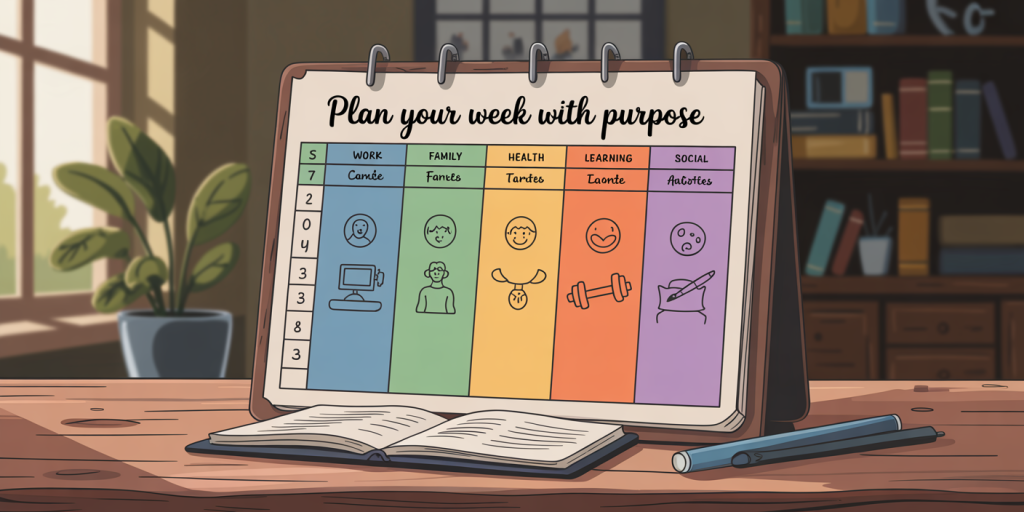Designing Your Ideal Week: A Blueprint for Purposeful Living
In today’s fast-paced world, the notion of “busy” often overshadows our ability to live purposefully. Many individuals find themselves overwhelmed by constant to-do lists, shifting priorities, and the relentless pressure to perform across personal and professional spheres. The result is a life that feels reactive rather than intentional. Designing your ideal week offers a strategic method to take back control, aligning your time with your core values and long-term goals. This approach empowers you to move beyond mere productivity to achieve fulfillment, balance, and growth.
Purposeful living means harnessing time intentionally. Research from the Harvard Business Review shows that people who plan their weeks in advance are 25% more likely to report high satisfaction in both their professional and personal lives. Allocating specific time slots for tasks aligned with your priorities ensures focus, reduces decision fatigue, and increases overall happiness. By crafting a weekly blueprint, you can delineate not just what needs to be done, but why it matters, creating momentum for meaningful achievements.
Understanding Your Priorities: The Foundation of an Ideal Week
Before you can design an ideal week, clarity about your priorities is essential. Priorities aren’t just tasks or milestones; they encompass your values, relationships, health, career, and personal development. According to a survey by Gallup, people who regularly set goals aligned with their values feel 42% more engaged in their daily activities. To begin, categorize your priorities into key life domains such as work, family, health, learning, and social life.

Consider the example of Sarah, a mid-level marketing executive and mother of two. Sarah started by listing her core priorities: career growth, family time, fitness, and hobby development (painting). She realized that her typical workweeks were heavily skewed toward meetings and email management, leaving minimal time for family or self-care. Understanding this imbalance helped Sarah to consciously allocate time blocks for each priority, making her week more balanced and fulfilling.
A simple yet effective method for identifying priorities is to rate each area on a scale from 1 to 10 based on satisfaction and importance. Areas rated high on importance but low on satisfaction signal urgent attention. This prioritization approach guides the allocation and protects time for what matters most in the week ahead.
Time Blocking: Structuring Productivity with Purpose
Once priorities are clear, the next step is time blocking—reserving specific chunks of time for focused work aligned with your priorities. Time blocking mitigates multitasking and context switching, both linked to productivity losses up to 40%, according to a study published in the Journal of Experimental Psychology. By dedicating specific hours to tasks (e.g., email from 9-10 am, project work from 10-12 pm), you not only enhance efficiency but create rhythms that honor your energy levels throughout the day.
For example, John, a freelance software developer, found his productivity spikes in the morning hours. He structured his ideal week by blocking key project development tasks between 8 am and 12 pm, followed by client meetings in the afternoon, and personal errands or exercise in the early evening. This allocation significantly reduced distractions and increased his billable hours by 15%.
Integrating buffer times within your schedule is equally vital. Don’t overschedule; leave room for unexpected events, breaks, and transitions. Empirical data from RescueTime indicates that highly productive people spend about 60-70% of their working hours on focused tasks and the remainder on meetings, emails, and rest. Time blocking also plays a crucial role in preventing burnout by incorporating rest periods, improving overall well-being.
| Time Blocking Benefits | Description | Example |
|---|---|---|
| Increased Focus | Minimizes multitasking, allows deep work | Developer coding 8-12 pm |
| Energy Management | Aligns tasks with natural energy levels | Creative work in mornings |
| Reduced Decision Fatigue | Pre-decided schedule minimizes routine decision-making | Fixed email hours daily |
| Work-Life Balance | Allocates time to personal and professional areas | Family time at 6-7 pm |
| Space for Flexibility | Buffer times accommodate interruptions and rest | 15-minute breaks between tasks |
Leveraging Technology and Tools for Efficient Planning

In the digital era, technology is an indispensable ally in designing and maintaining your ideal week. Various apps and platforms can help visualize your schedule, send reminders, and track progress on goals. A 2023 survey by Statista revealed that 68% of knowledge workers use calendar management tools to enhance productivity, demonstrating a widespread acknowledgment of their effectiveness.
Google Calendar and Microsoft Outlook remain the most popular tools for time blocking, offering seamless integration across devices and syncing with other applications. For task management, apps like Todoist, Trello, and Asana help break weekly goals into manageable daily actions, with priority tags and deadlines to keep you on track.

Consider Maria, an entrepreneur managing multiple business ventures. She uses Trello to organize weekly objectives for each project and Google Calendar to allocate time slots for meetings and focused work. Combining both tools makes her week visually manageable and less mentally overwhelming, facilitating consistent progress without burnout.
Automation can also reduce cognitive load. Setting recurring events for habits like exercise, meditation, or family dinners turns them into non-negotiable slots. Moreover, integrating productivity techniques like Pomodoro (25-minute focused sessions with breaks) within your week enhances deep work capacity, supported by timers available on many productivity platforms.
Real-Life Adjustments: Flexibility Within Structure
While structure forms the backbone of your ideal week, flexibility ensures sustainability. Life is unpredictable; emergencies, spontaneous opportunities, or mood variations require a certain fluidity that prevents rigid plans from becoming burdensome. Striking a balance between discipline and adaptability is key for long-term success.
Take the example of David, an academic juggling teaching, research, and family commitments. Initially, David’s rigid weekly plan left no room for unexpected research breakthroughs or family events, causing frustration. By leaving certain afternoons open as “flex time,” he created a vital pressure valve that reduced stress and increased responsiveness to real-time situations.
Data supports this approach: according to the American Psychological Association, workers who report flexible work schedules experience 25% lower stress and 15% higher job satisfaction. Flexibility can be implemented by marking “core working hours” during which essential tasks and meetings happen, while reserving other periods for discretionary work or rest.
| Fixed Schedule Features | Flexible Schedule Features | Best Use Case |
|---|---|---|
| Predictability | Adaptability | Routine tasks, meetings |
| Minimizes procrastination | Reduces burnout, stress | Creative work, family commitments |
| Easier collaboration | Better response to emergencies | Team coordination |
| Can feel restrictive | Risk of lack of discipline | Self-driven projects |
The ideal blueprint incorporates granted flexibility within a defined framework, encouraging both reliability and resilience.
Measuring Progress and Reflecting Weekly
Designing your ideal week is an evolving process that requires consistent measurement and reflection. Without periodic evaluation, it’s challenging to affirm whether your time is producing the desired outcomes or if adjustments are needed. Reflection deepens awareness and refines future weeks with more precision.
One practical approach is to schedule weekly review sessions. During this time, reflect on questions such as: Which activities energized or drained me? Did I allocate time to all priority areas? What unexpected events disrupted my plan, and how did I respond? What progress did I make toward my long-term goals?
For instance, Lisa, a project manager, conducts a Sunday review. She journals her accomplishments, obstacles, and emotions related to the past week and revises her next schedule accordingly. This habit has increased her project delivery rate by 20% and drastically improved her work-life harmony.
Quantitative tracking of metrics such as hours spent per domain or task completion rates complements reflection. Tools like RescueTime or Toggl Track allow you to monitor actual versus planned time, highlighting discrepancies and areas for improvement.
Looking Ahead: Future Perspectives on Managing Time with Purpose
As work environments continue to evolve — with remote work, gig economies, and AI integration reshaping day-to-day activities — designing your ideal week holds even greater significance. Purposeful scheduling is a skill that will increasingly differentiate high performers and satisfied individuals in an era flooded with distractions and demands.
Emerging technologies promise smarter calendar management systems powered by AI, capable of dynamically adjusting your weekly plans based on real-time inputs such as productivity patterns, energy levels, and shifting priorities. For example, AI-driven assistants might suggest optimal times to schedule focused work or breaks by analyzing your biometrics and digital activity, fostering well-being and effectiveness.
Moreover, the cultural shift toward work-life integration calls for frameworks that respect holistic human needs. Rather than rigid compartmentalization, future blueprints may embody cycles of intense focus punctuated by restorative activities tailored individually. Incorporating mental health tracking, social connection time, and creativity boosts will become mainstream in weekly design.
Regardless of technology, the core principle remains timeless: intentionally allocating your time to what matters most creates a life of purpose and fulfillment. By continuously refining your weekly blueprint, grounded in your values and real-world context, you position yourself not just to survive, but to thrive.
Through understanding priorities, disciplined time blocking, leveraging tools, embracing flexibility, and regularly reflecting on progress, your ideal week becomes a dynamic roadmap. Countless professionals and leaders credit tailored weekly planning as the secret to productivity and well-being—why not design one for yourself, and start living more purposefully today?
